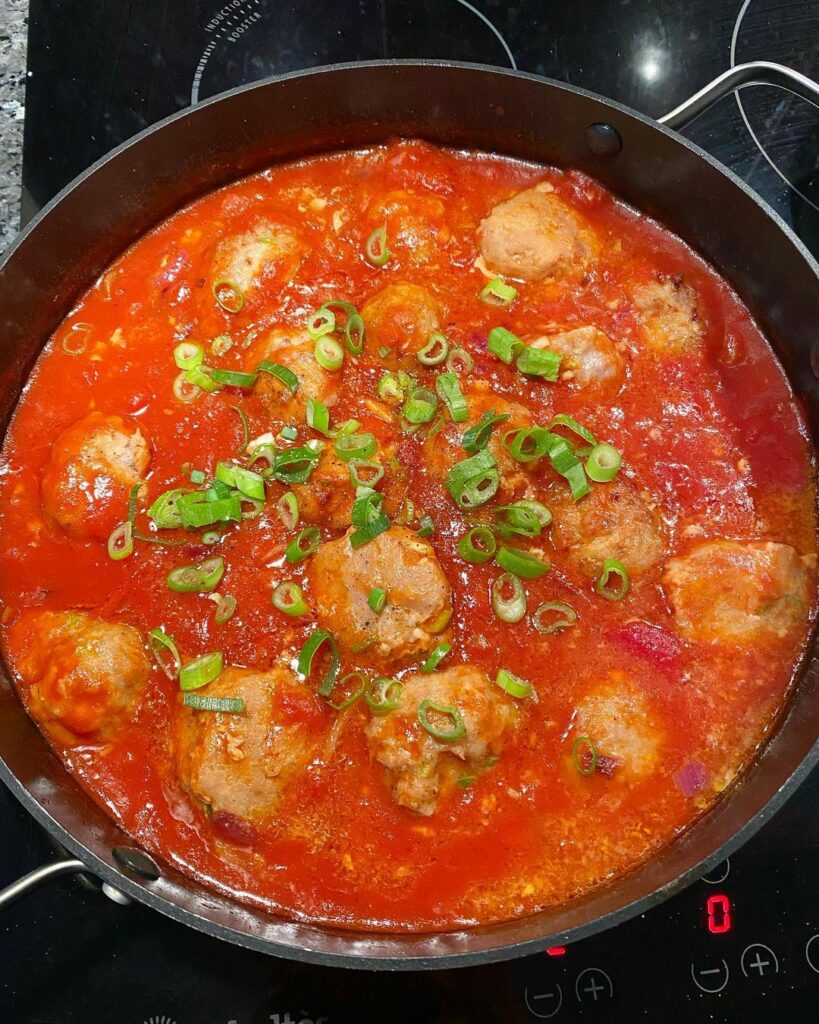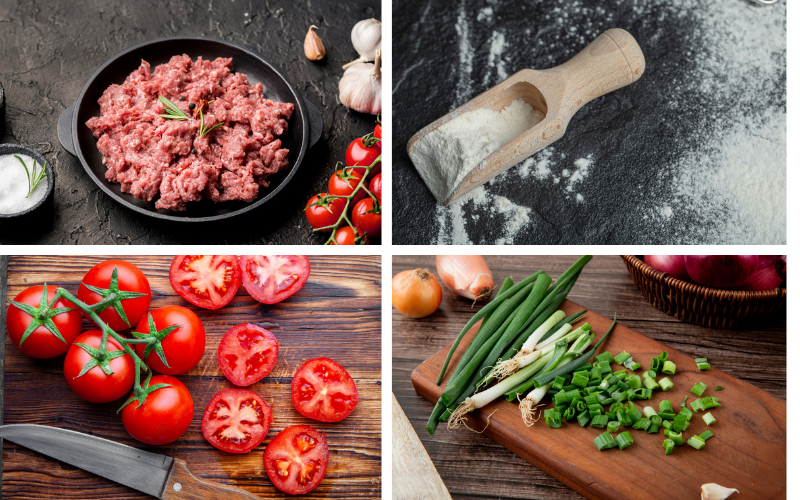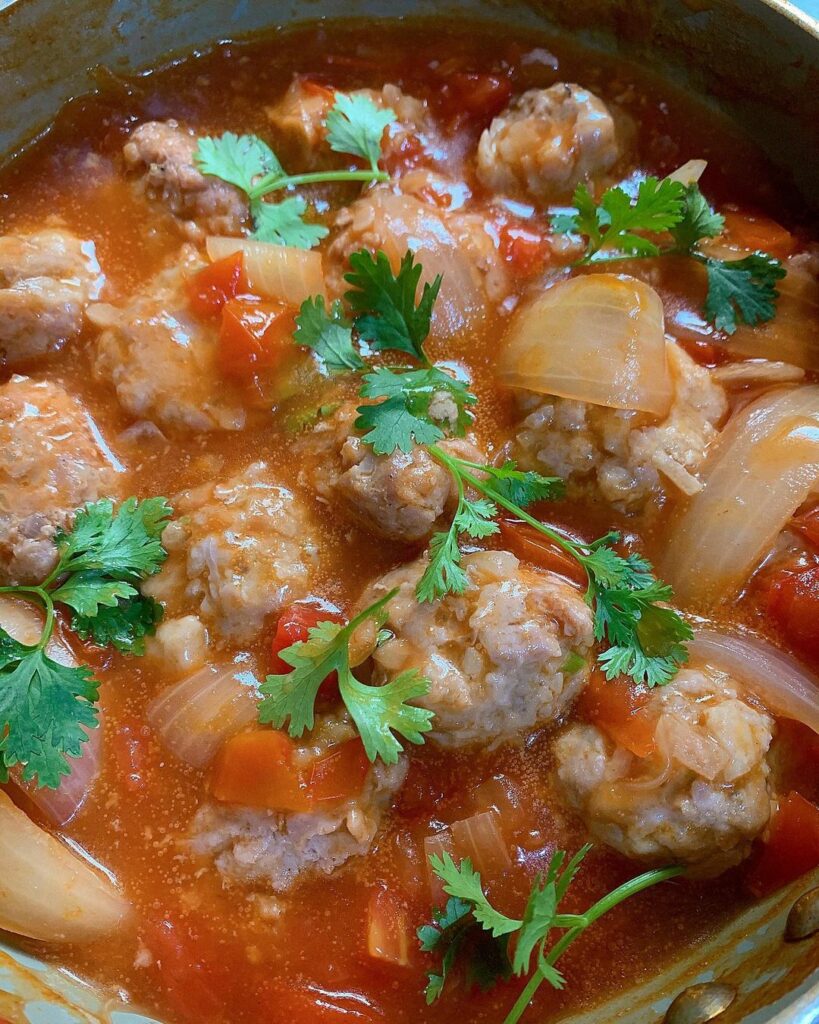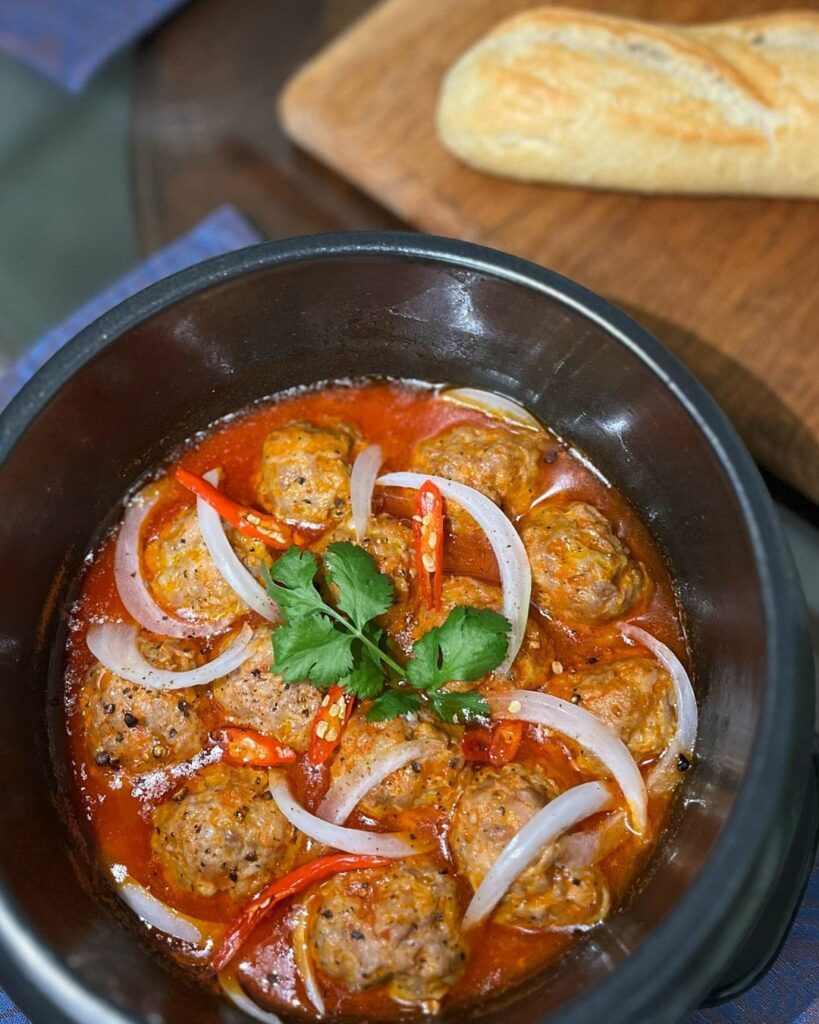Vietnamese meatballs, also known as Xiu Mai, are a dish that holds a special place in my heart. Growing up, my family would make them on special occasions or as a comforting meal on a chilly day. The combination of pork, jicama, and savory spices creates a unique and delicious flavor that I’ve always loved.
As I’ve grown older, I’ve continued to enjoy Xiu Mai in Vietnamese restaurants and have even learned to make them myself. Whenever I take a bite of these meatballs, I’m transported back to memories of home and the warmth of my family’s love.
What’s Xiu Mai?

Vietnamese meatballs, also known as Xiu Mai in Chinese cuisine, are small meatballs made from ground pork, onions, garlic, and various other ingredients such as fish sauce, sugar, and black pepper. These meatballs are typically served in a tomato-based sauce with rice or Vietnamese baguette.
Xiu Mai, also known as Vietnamese meatballs, is a popular dish in Vietnamese cuisine rooted in Chinese cuisine. It is commonly enjoyed as a part of Vietnamese breakfast and was introduced to Vietnam by Chinese immigrants. Over time, Xiu Mai has become a beloved staple in Vietnamese cuisine, often sold by street vendors.
While Xiu Mai is most commonly associated with Cantonese cuisine, it has many variations across China. In northern China, Xiu Mai is made with beef or lamb and is seasoned with cumin, giving it a distinct flavor.
In Shanghai, Xiu Mai is made with pork and is often served in a sweet and savory sauce. In Sichuan cuisine, Xiu Mai is made with pork and is seasoned with Sichuan peppercorns and chili peppers, giving it a spicy flavor.
Vietnamese Xiu Mai recipe

The Vietnamese Xiu Mai recipe is going to be a bit heavy with ingredients, so consider them so you don’t come short.
Cooking note
- Yield: 4–6 servings
- Prep Time:
- 15 minutes
- Cook Time: 30 minutes
- Total Time: 45 minutes
- Course: Main dish
- Cuisine: Vietnamese
- Equipment: Boxed Grater, Mixing Bowls, Steamer Pot
Ingredients
Meatballs
- 1 lb ground pork
- 4 oz or 1 cup jicama, finely diced
- 3 green onions, chopped
- 1/2 tsp minced garlic
- 1 Tbsp fish sauce
- 1 Tbsp cornstarch
- 1/2 tsp ground black pepper
Tomato sauce
- 2 lbs or 4 medium tomatoes, chopped
- 1/2 Tbsp vegetable oil
- 1/2 Tbsp minced garlic
- 1 1/2 Tbsp tomato paste
- 1 Tbsp sugar
- 1 Tbsp fish sauce
- 1 1/2 cups water
- 1/4 tsp ground black pepper
- 2 tsp cornstarch
- 2 tsp water
How to make Xiu Mai?
- In a mixing bowl, combine the ground pork, jicama, green onions, minced garlic, fish sauce, cornstarch, and black pepper. Mix all the ingredients together until well combined.
- Take a small portion of the mixture (about 1 tablespoon) and roll it into a ball. Repeat with the remaining mixture.
- In a large pot, heat the vegetable oil over medium heat. Add the minced garlic and cook until fragrant.
- Add the chopped tomatoes, tomato paste, sugar, fish sauce, water, and black pepper to the pot. Stir well and bring to a simmer.
- Carefully drop the meatballs into the tomato sauce. Cover and let it simmer for about 15–20 minutes, or until the meatballs are cooked through.
- In a small bowl, mix the cornstarch and water until dissolved. Slowly pour the cornstarch mixture into the tomato sauce while stirring.
- Continue cooking the tomato sauce until it thickens to your desired consistency.
- Serve the meatballs and tomato sauce hot with steamed rice.
How long to steam Xiu Mai?
The length of time to steam xiu mai will depend on the size and thickness of the meatballs. Generally, xiu mai should be steamed for around 10 to 15 minutes, or until they are cooked all the way through and are no longer pink in the center.
It’s important to use a steamer basket and to make sure that the meatballs are spaced apart so that they don’t stick together. After steaming, let the xiu mai cool for a few minutes before serving with your desired dipping sauce.
Xiu Mai nutritional value
Sure, here is a table with the nutritional value of Vietnamese meatballs (Xiu Mai):
| Nutrient | Amount |
| Calories | 240 |
| Protein | 18g |
| Fat | 12g |
| Carbohydrates | 15g |
| Fiber | 2g |
| Sugar | 3g |
| Sodium | 730 mg |
Health Benefits and Drawbacks of Xiu Mai
Health Benefits: Xiu Mai can be a good source of protein and can be a filling and satisfying meal. However, it is important to be mindful of the sodium content in the dish, which can be high due to the use of fish sauce and other seasonings.
Drawbacks: The fat content of Xiu Mai can be quite high, depending on the type of meat used and the ratio of meat to vegetables. Additionally, some recipes may include added sugar, which can increase the calorie content of the dish. The use of processed meats or meat with high-fat content can also contribute to an unhealthy diet. It is important to enjoy Xiu Mai in moderation as part of a balanced diet.
Tips and tricks for making the perfect Xiu Mai

Sure, here are some tips and tricks for making the perfect Xiu Mai:
- Meat Selection: Choose the right meat for your Xiu Mai. Ground pork is the most common choice, but you can also use beef, chicken, shrimp, or fish, depending on your preference.
- Ratio of Ingredients: Get the right ratio of ingredients for your Xiu Mai. A good rule of thumb is to use equal parts of meat and vegetables (such as onions, carrots, and mushrooms), and then add seasonings, such as fish sauce, soy sauce, and sugar, to taste.
- Mixing: Mix the ingredients thoroughly but avoid overworking the meat mixture, which can result in tough meatballs. Use a gentle hand and mix until the ingredients are evenly distributed.
- Shaping: When shaping the meatballs, use your palms to roll the mixture into a ball, and then use your fingers to create a slight indentation in the center. This will help the meatballs cook evenly and prevent them from falling apart.
- Cooking: Steaming is the most common method of cooking Xiu Mai, but you can also fry or grill them. If you’re steaming them, be sure not to overcrowd the steamer basket, which can cause the meatballs to stick together.
- Serving: Xiu Mai is traditionally served with steamed rice and a dipping sauce, such as a mixture of soy sauce, vinegar, and chili oil. You can also serve them as an appetizer or in soup.
What is serving and suggestion Xiu Mai?
Sure, here are some serving suggestions for Xiu Mai:
- As a main dish: Serve Xiu Mai as a main dish with steamed rice and a side of vegetables, such as stir-fried bok choy or broccoli.
- Bread: Bread can be eaten with Xiu Mai by being able to sandwich Xiu Mai in bread, or you can eat Xiu Mai by dipping it in a bowl of Xiu Mai with the same soup as in Da Lat.
- As an appetizer: Serve smaller-sized Xiu Mai as an appetizer with toothpicks or skewers. You can also serve them with a dipping sauce.
Variations with Xiu Mai
Sure, here are some variations you can try with Vietnamese meatballs:
- Shrimp and Pork Xiu Mai: Combine ground pork and chopped shrimp in equal parts to make a seafood version of Xiu Mai.
- Vegetarian Xiu Mai: Replace the meat with chopped mushrooms and/or tofu and add other veggies, such as shredded carrots and cabbage, to make a vegetarian version of Xiu Mai .
- Xiu Mai salted egg: Add salted egg mixed to the meat, salt salted egg taste, you should reduce the saltiness when adding spices to the meat.
- Cheese Xiu Mai: Mix in some shredded cheese, such as cheddar or mozzarella, to the meatball mixture for a cheesy twist or you can also have a layer of cheese to eat with Xiu Mai for extra fat, served with bread.
What are the substitute ingredients in Xiu Mai?
Some substitute ingredients you can use in Vietnamese meatballs:
- Meat Substitutes: You can use ground chicken, beef, shrimp, or fish instead of pork in your meatballs, depending on your preference.
- Vegetables: Instead of jicama, you can use other vegetables, such as grated carrots, shredded zucchini, or finely chopped mushrooms.
- Starches: Cornstarch can be replaced with other starches, such as potato starch or tapioca starch, to thicken the meatball mixture.
- Seasonings: You can adjust the seasonings to your liking by using different types of sauces and spices, such as oyster sauce, soy sauce, chili sauce, or ginger.
- Binders: If you don’t have cornstarch or other starches on hand, you can use breadcrumbs or eggs as a binder in your meatballs.
How to store Xiu Mai?
You can store cooked Vietnamese meatballs in an airtight container in the refrigerator for up to 2–3 days. If you’re storing uncooked meatballs, you can keep them in the refrigerator for up to 1–2 days before cooking. If Xiu Mai is left for too long, the substances can be changed and harmful to health.
In addtition, to warm Xiu Mai you need to use the microwave by the way place the meatballs on a microwave-safe plate and microwave on high for 1–2 minutes, or until heated through.
You also preheat your oven to 350 °F (175 °C) and place the meatballs on a baking sheet. Bake for 10–15 minutes, or until heated through.
Heating a skillet over medium heat and adding the meatballs. Cook for a few minutes on each side, or until heated through.
Where to find the best Xiu Mai?

Sure, here are some famous places in Vietnam that are known for their delicious Vietnamese meatballs (Xiu Mai) served with bread.
- Co Ut Xiu Mai bread: Despite the Xiu Mai’s size, it is not monotonous to eat. Xiu Mai’s bread-dipped sauce is extremely rich.
Address: 650 Doan Van Bo, District 4
Opening hours: 1 PM – 7 PM
- Delicious Xiu Mai bread in Saigon Co Phuong: The taste of the food is also particularly unique because the banh mi made here is prepared using an ancient recipe. The meat has a good marinade. The sauce has an alluring sweet and sour flavor and is thick.
Address: 4A Le Quang Sung, Ward 6, District 6,
Opening hours: 6AM – 11AM
- Hoang Dieu Da Lat Xiu Mai bread: Every region will have its own Xiu Mai traditions, and when people think of Xiu Mai, they almost always picture Xiu Mai Da Lat bread with ice cream and soup spicy, sweet.
Address: 26 Hoang Dieu, Ward 5, Da Lat City, Lam Dong
Opening time: 6AM – 9AM
FAQs
How to pronounce Xiu Mai?
Xiu Mai is pronounced as “shoo-my” in English.
Can Xiu Mai be made in advance?
Yes, Xiu Mai can be made in advance and stored in the refrigerator or freezer for later use. If you want to make Xiu Mai ahead of time, it’s best to cook them first and then store them in an airtight container in the refrigerator for up to 2–3 days.
You can also make the meatball mixture in advance and shape them into balls, then store them in the refrigerator for up to 1–2 days before cooking. This can be a great time-saving tip if you want to prepare the meatballs ahead of time for a party or gathering.
Can Xiu Mai be frozen?
Yes, Xiu Mai can be frozen for later use. To freeze Xiu Mai place the cooked meatballs on a baking sheet lined with parchment paper and freeze until firm. Then, transfer them to a freezer-safe bag or container and store them in the freezer for up to 1–2 weeks.
You can also freeze uncooked Xiu Mai by shaping them into balls and freezing them on a baking sheet until firm. Then, transfer them to a freezer-safe bag or container and store them in the freezer for up to 3–4 weeks. When you’re ready to cook them, simply thaw them in the refrigerator overnight and cook them according to your preferred method.
Freezing Xiu Mai is a great way to make them ahead of time and have a delicious and convenient meal option on hand whenever you need it.
Is Xiu Mai gluten-free?
The traditional recipe for Xiu Mai typically uses cornstarch as a binding agent, which is gluten-free. However, some variations of Xiu Mai may contain other ingredients that could potentially contain gluten, such as soy sauce or oyster sauce. It’s important to check the ingredients and preparation methods of the Xiu Mai you’re eating to ensure that it is gluten-free.
If you have a gluten allergy or sensitivity, it’s always best to consult with the restaurant or cook to ensure that the Xiu Mai is gluten-free before consuming it. Alternatively, you can make your own Xiu Mai at home using gluten-free ingredients to ensure that it is safe for you to eat.
How do you shape Xiu Mai?
To shape Xiu Mai, follow these steps:
- Take a small amount of the meat mixture and roll it into a ball that’s about the size of a golf ball.
- Hold the meatball in one hand and use your other hand to press down on it slightly to create a flat surface on the bottom.
- Use your thumb to make an indentation in the center of the meatball, making it look like a mini burger patty.
- Place the Xiu Mai on a plate or in a steamer basket, with the flat side facing down.
- Repeat these steps with the remaining meat mixture, spacing the Xiu Mai apart, so they don’t stick together when cooking.
By following these steps, you can create perfectly shaped Xiu Mai meatballs that are uniform and shape. It’s important to keep the flat side facing down when cooking, as this will help them cook evenly and prevent them from falling apart.
How to know if a Vietnamese meatball is cooked?
There are several ways to know if Vietnamese meatballs (xiu mai) are fully cooked:
- Check the internal temperature: Use a meat thermometer to check the internal temperature of the meatballs. Pork should reach an internal temperature of 160°F (71°C) to be fully cooked.
- Cut open a meatball: Cut open one of the meatballs to check the color of the center. It should be cooked all the way through and no longer pink.
- Check the texture: Fully cooked xiu mai will have a firm and springy texture. If the meatballs are soft and mushy, they may need more time to cook.
- Observe the juices: If the juices run clear when you cut into a meatball, it’s a sign that it’s fully cooked.
It’s important to make sure that the xiu mai are cooked all the way through to prevent any risk of foodborne illness.
What makes Xiu Mai different from other types of meatballs?
Xiu Mai meatballs are different from other types of meatballs in several ways.
- First, the texture of Xiu Mai is typically softer and more delicate than other types of meatballs. This is due to the addition of jicama, which gives the meat mixture a light and airy texture.
- Second, the flavor of Xiu Mai is unique and distinct. It’s made with a combination of traditional Vietnamese spices and seasonings, including fish sauce, garlic, and black pepper, which give it a savory and umami-rich taste.
- Third, Xiu Mai is traditionally served with a tomato-based dipping sauce, which adds a tangy and sweet flavor that complements the savory meatballs. This sauce is often made with tomato paste, sugar, fish sauce, and other seasonings, and is an essential component of the dish.
Xiu Mai stands out from other types of meatballs due to its unique texture, flavor, and accompanying sauce, which all combine to create a delicious and satisfying meal.
What is the best dipping sauce for xa xiu?
The best dipping sauce for Xiu Mai is typically a sweet and tangy tomato-based sauce. This sauce is traditionally made with tomato paste, sugar, fish sauce, and other seasonings, and is an essential component of the dish.
To make the dipping sauce, combine tomato paste, sugar, fish sauce, garlic, and water in a small saucepan and cook over medium heat until it thickens and becomes a smooth and glossy sauce. You can adjust the sweetness and saltiness to your liking by adding more sugar or fish sauce.
Other popular dipping sauces for Xiu Mai include chili sauce, soy sauce, and hoisin sauce. Some people also like to dip their Xiu Mai in a combination of soy sauce and lime juice, which gives it a tangy and slightly sour flavor.
What are some traditional drinks that pair well with Xiu Mai?
There are several traditional drinks that pair well with Xiu Mai. Here are some popular options:
- Tea: Hot tea, particularly green tea or jasmine tea, is a classic pairing for Xiu Mai. The light and refreshing flavor of the tea helps to balance the savory and umami-rich taste of the meatballs.
- Beer: Beer is another popular choice to pair with Xiu Mai. A light lager or pilsner is a good choice, as the crisp and refreshing flavor complements the meatballs well.
- Coconut water: Coconut water is a refreshing and hydrating beverage that pairs well with the spiciness of Xiu Mai. The natural sweetness of the coconut water also helps to balance the saltiness of the meatballs.
- Soda: A cold soda, particularly a citrusy or fruity flavor, can be a refreshing pairing for Xiu Mai. The sweetness and carbonation help to balance the savory flavors of the meatballs.
The best drink to pair with Xiu Mai is a matter of personal preference, but these traditional options are all delicious and complement the dish well.
What holidays are served Xiu Mai in Vietnam?
Xiu Mai is a popular dish in Vietnam and is served on a variety of occasions, including holidays. One of the most significant holidays in Vietnam is Tet, the Lunar New Year, where families often gather together and share a variety of traditional dishes, including Xiu Mai.
Other holidays, such as weddings and family reunions, may also feature Xiu Mai as part of the menu. However, Xiu Mai can be enjoyed year-round in Vietnam and is a staple dish in many households and restaurants.
Conclusion
Finally, Xiu Mai is a delicious and popular dish in Vietnamese cuisine. These juicy and flavorful meatballs are typically made with ground pork, jicama, and a variety of spices and seasonings, and are often served with a tomato-based dipping sauce.
While Xiu Mai are traditionally made with pork, they can also be made with other types of meat, such as beef, chicken, shrimp, or fish. They can also be adapted to be gluten-free or vegetarian/vegan, making them a versatile and inclusive dish.
Whether you’re dining at a popular restaurant or making Xiu Mai at home, these meatballs are a delicious and comforting meal option that can be enjoyed by people all around the world.
More Vietnamese recipes made from pork